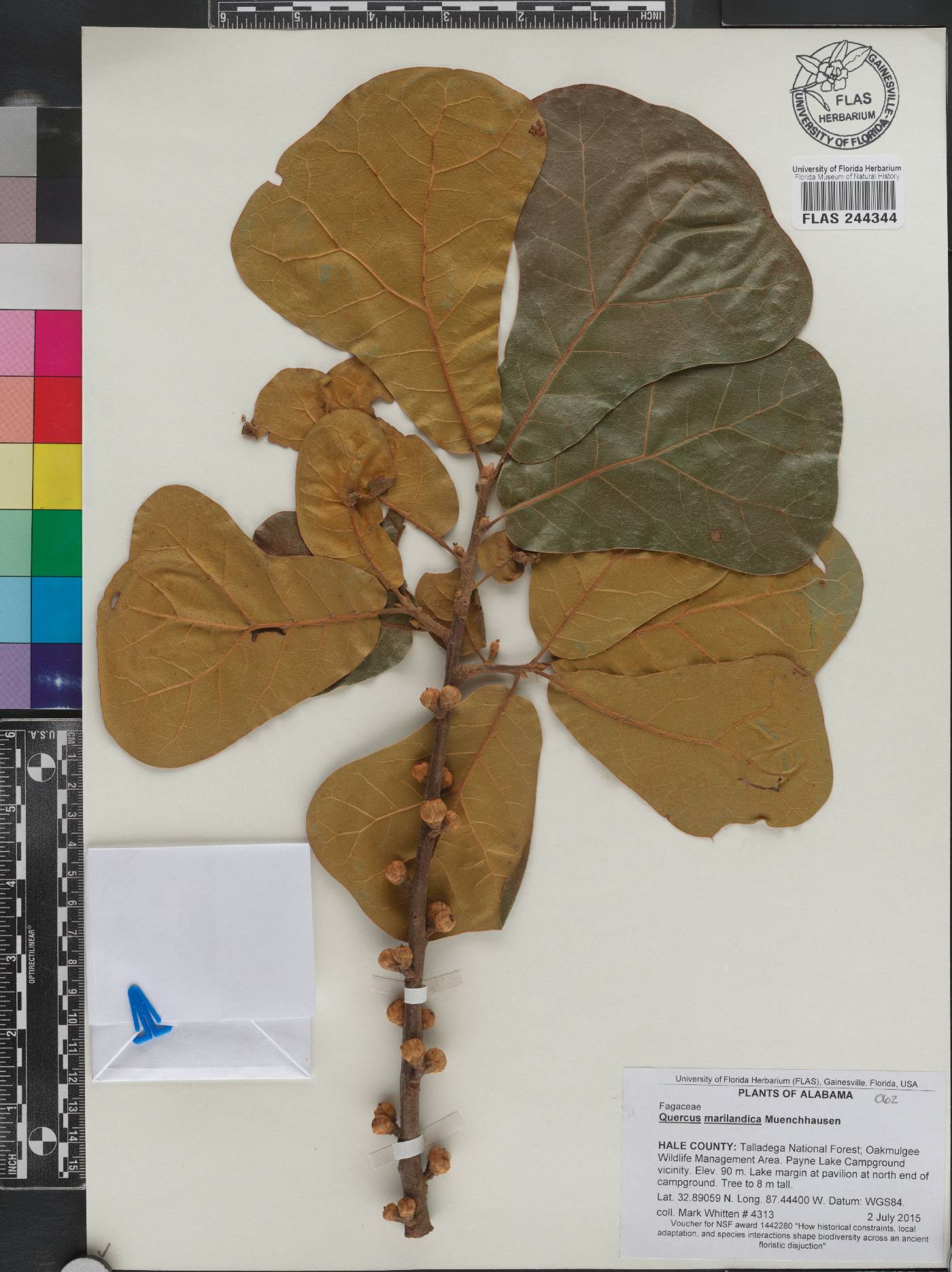|
|
|
|
Family: Fagaceae
blackjack oak, more...blackjack oak
[Quercus marilandica var. ashei Sudw., moreQuercus neoashei Bush, Quercus nigra var. marilandica L.] |
Trees , deciduous, to 15 m. Bark almost black, with irregular or rectangular blocks, inner bark orangish. Twigs ashy brown, (1-)2-4(-5) mm diam., pubescent to tomentose. Terminal buds conic or narrowly ovoid-ellipsoid, 5-10 mm, noticeably 5-angled in cross section, tawny pubescent. Leaves: petiole 5-20 mm, densely to sparsely pubescent. Leaf blade obovate to obtrullate, (50-)70-200 × (40-)70-200 mm, base rounded or cordate, blade not decurrent, margins with 3-5 shallow, often very broad lobes and 3-10 awns, apex acute to obtuse, rarely rounded; surfaces abaxially scurfy or with scattered pubescence, adaxially glossy, glabrous, secondary veins raised on both surfaces. Acorns biennial; cup turbinate, 6-10 mm high × 13-18 mm wide, covering 1/3 nut, outer surface puberulent, inner surface pubescent, scale tips loose, especially at margin of cup, acute or acuminate; nut broadly ovoid or ellipsoid, 12-20 × 10-18 mm, often striate, glabrate, scar diam. 5-8 mm. 2 n = 12. [R. C. Friesner 1930. J. W. Duffield (1940) suggested that Friesner was counting bivalents; if so, then 2 n = 24, consistent with all other reports for Quercus .] Flowering spring. Poor shallow soils of glades, barrens and flatwoods, disturbed fields, rocky outcrops, and dry ridges; 0-900 m; Ala., Ark., Del., D.C., Fla., Ga., Ill., Ind., Iowa., Kans., Ky., La., Md., Miss., Mo., Nebr., N.J., N.Y., N.C., Ohio, Okla., Pa., S.C., Tenn., Tex., Va., W.Va. Evidence suggests that small trees from the western portion of the range (primarily Texas and Oklahoma) should be recognized as Quercus marilandica Münchhausen var. ashei Sudworth (D. M. Hunt 1989). These trees are characterized by 50-70 × 40-60 mm leaf blades with abaxial surfaces gray-tomentose in vein axils. Quercus marilandica reportedly hybridizes with Q . buckleyi and Q . falcata (E. J. Palmer 1948); and with Q . georgiana , Q . ilicifolia (= Q . × brittoni W. T. Davis), Q . imbricaria [= Q . × tridentata (A. de Candolle) Engelmann], Q . incana , Q . nigra , Q . phellos ( Q . × rudkini Britton), and Q . velutina (= Q . × bushii Sargent). D. M. Hunt (1989) cited evidence of hybridization also with Q . arkansana , Q . hemisphaerica , Q . laevis , Q . laurifolia , Q . myrtifolia , Q . palustris , and Q . rubra . The Choctaw used Quercus marilandica to ease cramps and to aid in childbirth (D. E. Moerman 1986).
Small or medium-sized tree with deeply checked bark and thinly pubescent twigs; buds densely pubescent, 5-8 mm; lvs broadly obovate or triangular- obovate, mostly (6-)10-20(-30) cm and half to fully as wide, shallowly and broadly 3-lobed across the summit, rarely with additional lobes below, sometimes nearly or quite entire, rounded or subcordate at base, brownish-green beneath with minute, closely appressed hairs, rarely softly stellate-tomentose; petioles mostly 0.5-1.5 cm; acorns 1.5-2 cm, the cup turbinate, enclosing half the nut, its scales relatively few and large, sericeous. Dry or sterile, especially sandy soil; s. N.Y. to s. Io., s. to Fla. and Tex. The vegetatively persistent, often locally abundant hybrid with Q. ilicifolia is Q. آrittonii W. T. Davis. Gleason, Henry A. & Cronquist, Arthur J. 1991. Manual of vascular plants of northeastern United States and adjacent Canada. lxxv + 910 pp. ©The New York Botanical Garden. All rights reserved. Used by permission. |



